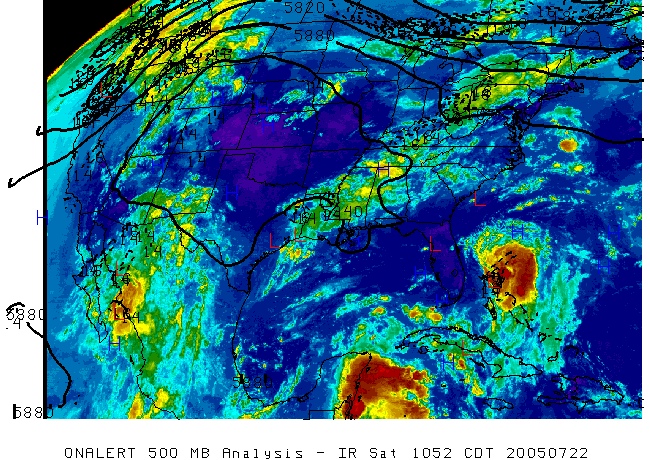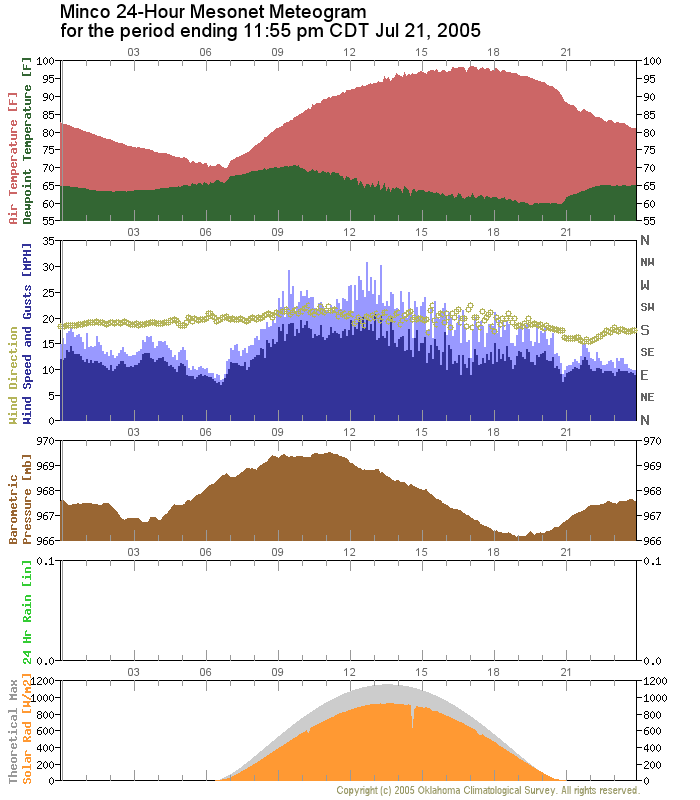Ticker for July 22, 2005
MESONET TICKER ... MESONET TICKER ... MESONET TICKER ... MESONET TICKER ...
July 22, 2005 July 22, 2005 July 22, 2005 July 22, 2005
The Prints of Tides
This week's weather can be described in just a few words, even fewer
if you decide to leave out the expletives. A giant ridge remains
parked over most of the continent, centered pretty much on Oklahoma.

Ridges, as you know, are the atmosphere's purveyors of persistence,
and this one has dictated some pretty boring - and hot - weather
over our patch of Earth.
But, to employ an inappropriate metaphor, let's try to find a silver
lining here. In other words, we're going to take a persistent and
disappointing summertime pattern and find some beauty in it.
And it's not that hard to do - if you've ever rooted for the Cubs,
you're already an expert at this.
The lack of anything dynamic in our current configuration is just
a long, quiet, pause. In our human lives, we use these opportunities
to peel back the daily noise of our existence and find subtle
signals. Well, in much the same way, we can use this quiescent
period and our trusty meteogram to find subtle rhythms in the
atmosphere.
Take a look at yesterday's meteograms from Minco and Woodward:


Not too exciting, huh? No, not very. Now take a look at the pressure
traces at each station. Notice a sine wave (valley-peak-valley-peak)?
This is evidence of a semi-diurnal oscillation, a twice-daily ebb and
flow of pressure. This rhythm is always present, but it shows up more
clearly when strong forcing subsides. We used the term "ebb and flow"
intentionally, because "semi-diurnal oscillation" is just a fancy term
for atmospheric tides.
They are much like oceanic tides: a global-scale sloshing of a fluid,
dependent on the positioning relative to a celestial body.
They are also different than oceanic tides, in that the fluid is air,
not water. Moreover, they are much more strongly tied to the sun than
the moon, and they feature a strong thermal component (as opposed
to gravitational).
So, even in the doldrums of July, a meteogram can see the bright side
of things. All we need is a little atmospheric meditation.
July 22 in Mesonet History
| Record | Value | Station | Year |
|---|---|---|---|
| Maximum Temperature | 112°F | GRA2 | 2018 |
| Minimum Temperature | 56°F | GOOD | 2006 |
| Maximum Rainfall | 2.75″ | BEAV | 2015 |
Mesonet records begin in 1994.
Search by Date
If you're a bit off, don't worry, because just like horseshoes, “almost” counts on the Ticker website!